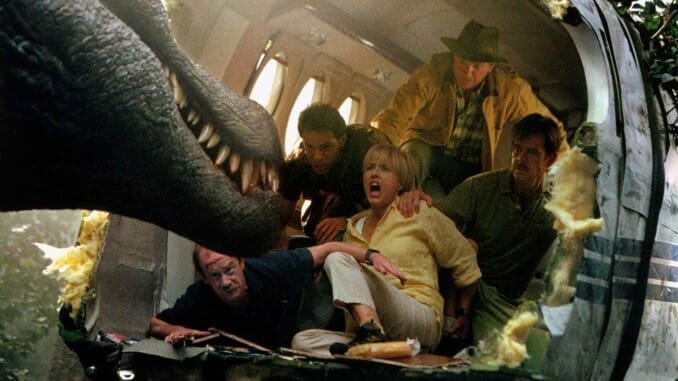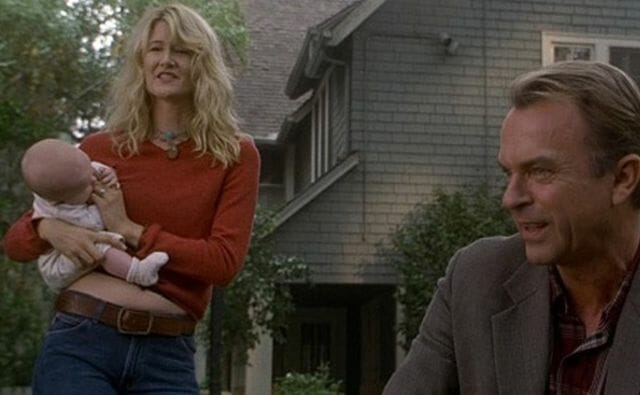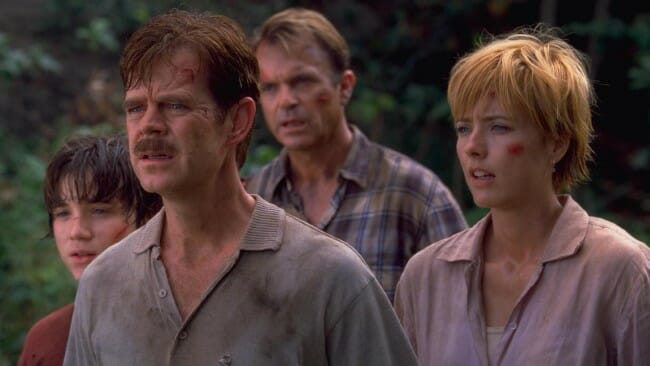Two Decades Later, Jurassic Park 3 Is a Chaotic, Black Sheep Time Capsule
Photos via Universal Pictures
It may seem hard to believe, in retrospect, as we approach what appears to be a massive opening box office weekend for Jurassic World Dominion, that a return to the Jurassic setting seemed like less than a sure thing back in 2015 as the first Jurassic World lumbered into theaters. That film would go on shatter box office records with a nearly $1.7 billion worldwide take, affirming that yes, people still enjoy a good old-fashioned CGI creature bonanza on the big screen, but it’s important to note that the massive success of Jurassic World wasn’t something that could be taken for granted at the time. Rather, feelings were tentative, and producers were likely concerned that the Jurassic franchise was still mired in a certain brand of existential malaise.
Which is to say, the malaise of 2001’s Jurassic Park 3. The black sheep of the Jurassic franchise, the failure of Joe Johnston’s uninspired return to Isla Sorna put big-budget dinosaur cinema into carbon freeze for roughly 14 years. Just over two decades removed from its summer release, Dr. Alan Grant’s first return to the Jurassic story now stands out for both its narrative oddities and its truly laborious production, which included a screenplay rewritten so many times that it was never actually completed in full while the movie was being filmed. It’s little wonder that Johnston later referred to the experience as “a living hell on a daily basis.”
So in honor of Dominion closing out the latest chapter in the dinosaur saga, let’s reexamine what went so very wrong with the first Jurassic trilogy capper.
A Mesozoic Mess of a Production
Jurassic Park 3 had the distinction of being the first entry in the series not helmed by populist directorial legend Steven Spielberg, who felt stifled by the production challenges of the first two Jurassic films and wanted to pass off the responsibility for a third installment after the mildly disappointing reception of first sequel The Lost World. For this job, he chose friend Joe Johnston of films such as Jumanji and The Rocketeer, with Spielberg intending to supervise the production fairly closely as an executive producer, presumably to ensure a certain tonal consistency. Spielberg, however, would go on to be absent from the set, busy with his own demanding work on 2001’s A.I. Artificial Intelligence, and one has to imagine his guiding hand was sorely missed in the cascading series of misfires that would follow.
The original concept for a Jurassic Park 3 was meant to be generated by Spielberg and author Michael Crichton, but this never came to be. Instead, screenwriter Craig Rosenberg was hired to produce the first version of the Jurassic Park 3 script, eventually turning out a story that “involved teenagers becoming marooned on Isla Sorna.” That script was summarily rejected, and the second crack at a Jurassic Park 3 screenplay was handled by writer Peter Buchman. His script was quite different, and would have simultaneously involved a Dr. Grant storyline on Isla Sorna, and a concurrent “mysterious dinosaur killings on the Costa Rican mainland” storyline. Until almost a month before production began on Jurassic Park 3, this remained the film’s working script.
However, a mere five weeks before filming was slated to begin, Johnston and Spielberg rejected the entire second script from Buchman, calling it unwieldy and overcomplicated. Following a suggestion from screenwriter David Koepp, who had written the first two films—but has no credit on Jurassic Park 3—Spielberg and Johnston decided to vastly simplify the overall scope of Jurassic Park 3 into a more generic “rescue mission” storyline, and hired screenwriters Alexander Payne and Jim Taylor to completely rewrite the script at the last minute. This, despite the fact that $18 million had already been spent on Jurassic Park 3 at this point, with Buchman’s screenplay fully storyboarded and budgeted, and sets already being constructed. The film’s story, meanwhile, was quickly becoming a hodgepodge of elements from all three versions of the screenplay, in order to salvage whatever work had already been completed.
It’s this hurried final leg of production that gave us Jurassic Park 3 elements such as the minimal inclusion of Dr. Ellie Sattler in the story, as her character hadn’t been included in either of the first two scripts by Rosenberg or Buchman. Nor was Laura Dern certain she wanted to return for a role that would essentially be a glorified cameo, until she was reportedly talked into the gig by the presence of Payne and Taylor, who had written her 1996 film Citizen Ruth. Spielberg, meanwhile, suggested the role Ellie would play in “saving” the stranded rescuers from afar, somehow giving Dern both the role of “single day shoot cameo” and “deus ex machina” in the same film.
 She totally pulled off the mom jeans, though.
She totally pulled off the mom jeans, though.
-

-

-

-

-

-

-

-

-

-

-

-

-

-

-

-

-

-

-

-

-

-

-

-

-

-

-

-

-

-

-

-

-

-

-

-

-

-

-

-

 It’s unknown if it was also clear to Macy how annoying the Kirby family would be as secondary protagonists.
It’s unknown if it was also clear to Macy how annoying the Kirby family would be as secondary protagonists.






































